- A – Summary of Community Composting Methods
- B – Home Composting
- C – Waste Management Vendor Directory
- D – Construction and Demolition Waste Management
- 1 What Constitutes C&D Waste?
- 2 How is C&D Waste Generated?
- 3 How can a C&D Processing Facility help the City?
- 4 References and Additional Material:
- 4.1 C&D WM Rules 2016
- 4.2 BBMP Notification (March 2016)- Guidelines for C&D Waste Management:
- 4.3 Karnataka State Pollution Control Board is responsible for ensuring the implementation of the C&D waste management rule 2016
- 4.4 High Court Direction (November 2015)
- 4.5 How C&D Waste Dumping is killing so many lakes in Bangalore
- E – Resource Recovery Center Project
A – Summary of Community Composting Methods
Here is an exhaustive list of SWM vendor list compiled by SWMRT.
Fantastic to see so many solutions for composting. There is something that will apply to every community’s needs. Kindly make an effort to check out solutions and start composting in the community.
How to do community composting using Organic Waste Converter –
| S.No | Attribute | Details |
|---|---|---|
| 1. | Name | Organic Waste Converter |
| 2. | # of households | 400 |
| 3. | Year Started | 2016 |
| 4. | Location | There is a vacant space in car parking area in basement which is just below the stairs. It is walled and is used for composting. There is another room in basement for collection of dry waste. The kabariwallah gets his vehicle inside and directly picks up the dry waste from the room itself |
| 5. | Vendor | Vennar Organic Fertilizer Pvt Limited |
| 6. | Specifications | Shredder OWC-60 Capacity The machine churns 20-25 kg of wet waste in just 10-15 min. |
| 7. | Vendor Roles & Responsibilities | Roles:Making the steel rakeInstallation of water dripping system above the rakeSupplying of accelerator – bioculum |
| 8. | Initial Expenses | Rs. 6,50,000 Total: Rs 6.5 LakhThe cost of the shredder – 4 LakhBuying of crates, making up of steel rakes, preparation of SWM room and dry waste collection room – 2.5 Lakh |
| 9. | Operational Expenses | Rs. 9,000 per month Total: Rs. 9,000+/monthSalary for person who operates OWC – Rs. 9000/month.20 bags of sawdust every month. |
| 10. | Revenue Source | Sale of dry waste generates around Rs 3,000 to 4,000 every month. |
| 11. | Time taken to Compost | 2 hours per day |
| 12. | Composting Method | Method Description:The society uses 2 bin- one bag approach for segregating the overall waste.The food waste which is generated every day, is then mixed with sawdust and is together put in the Organic Waste Convertor. In the machine itself, an accelerator called biocullum and sanifresh for managing odor problems is put along with the food waste.Once the food is shredded, it is filled in crates. Around 80 crates are used for composting 150 kg of food waste.These crates are then put on steel rakes which are kept there for 21 days. A dripping system is put above each rake. It runs for 2-3 min after every 4-5 hours. This helps in retaining the moisture level of the compost.After 21 days of curing in the rakes, the compost is ready to be used. |
| 13. | Compost Uses | Some of the compost is used by the gardener. What is left is taken up by the vegetable vendor who comes to sell organic vegetables in the society premises. The residents also can take the compost for their own purposes. |
B – Home Composting
1 Introduction
This article is about recycling of kitchen/organic waste. Composting is a process of converting food waste into nutrition rich soil which is called compost.

2 Why you should do home composting?
Composting is a process of recycling kitchen and garden waste. Its an easy process and is really amazing to see how nature works. One of the scientist in an Satymev Jayate episode gave a perfect example to think us seriously why should we do composting. He said that if you eat banana but if you don’t give it back to nature (just wasting it by dumping in landfill which again got mixed with plastic) your next generation will not get banana in future. So, do composting and grow your own safe and organic food.
3 What all you need for composting
Formula for Aerobic Composting:
Carbon + Nitrogen + Oxygen
Carbon – dry leaves,sawdust,wood scraps,newspaper, pencil scraps etc.
Nitrogen – Food scraps, coffee ground/used filters ,tea/tea bags,cut flowers/green leaves,corn cobs,eggshells etc.
To start you need:
- A pot/plastic bin with 1 or many holes
- Uncooked Kitchen waste (Nitrogen)
- Dry leaves (Carbon)
- Newspaper
- 1 spoon curd/buttermilk (To start aerobic process)
- Lid to cover pot
- Khurpi /broken stick to mix the pile

4 Process
- Take a pot with one or more holes in it to allow air.
- Place a newspaper to absorb extra moisture.
- Add a layer of soil or compost. For the first batch use soil instead of compost.
- Add vegetable/fruit scraps – (Nitrogen/Green).
- Add dry leaves -(Carbon/brown). Its better to fully dry semi dry leaves before use. Also crush them before mixing with the pile to make process better.
( Nitrogen and carbon ratio should be approximately 1:3. 1 part food scraps and 3 parts of dry leaves). - Make a layer of kitchen waste and dry leaves again to form a heap.
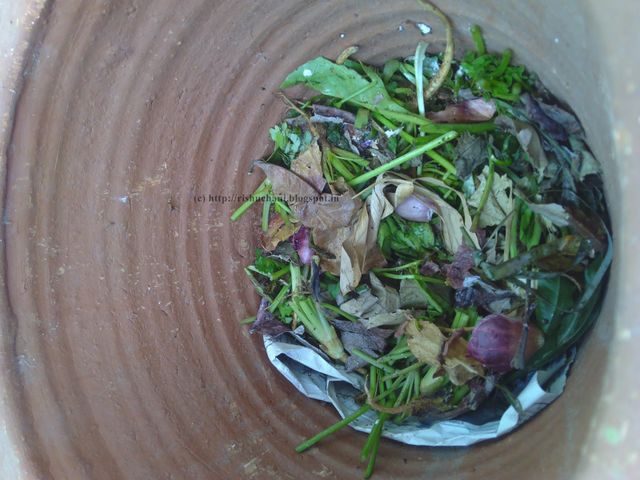
- With kitchen waste add 1 tbsp of curd/buttermilk to activate process.
- cover the heap with a newspaper or dry leaves like shown in below image. This step is necessary to avoid flies.
- cover pot with a lid.
Keep a plate under the pot to collect if any excess liquid is coming out which is called ‘Leachate’ ,which is very nutritious for plants. You will get very little/few drops in a day, which is unnoticeable. Some people collect it for a month or so and use in plants.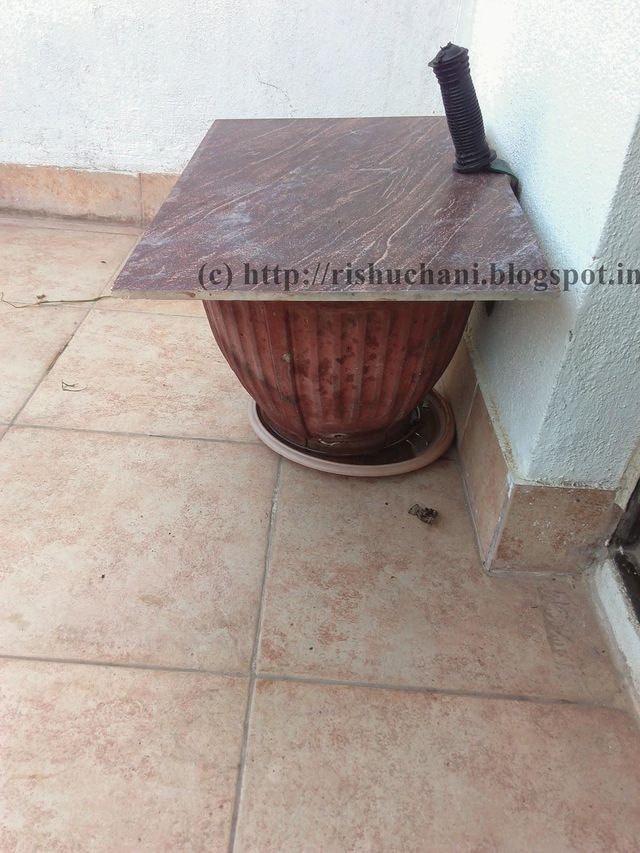
- Next day add greens and brown and mix different materials. Add them in composting bin. After adding mix follow 9th (cover heap with newspaper/dry leaves) and 10th (cover pot with lid) step daily until your bin/pot is full.
- Turn your pile regularly to produce a sweet smelling pile that will decompose faster.
After 6 to 8 days pile will look like below image: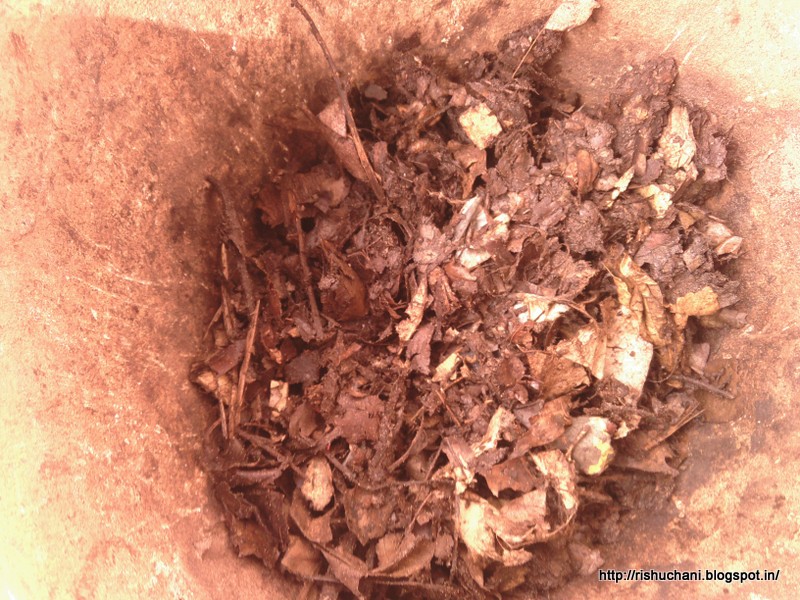
- Once your pot is full ,use another pot to continue this process. turn pile in first pot once in a week. After 30 to 45 days your compost will get ready.
- Final product (compost) looks like below image.
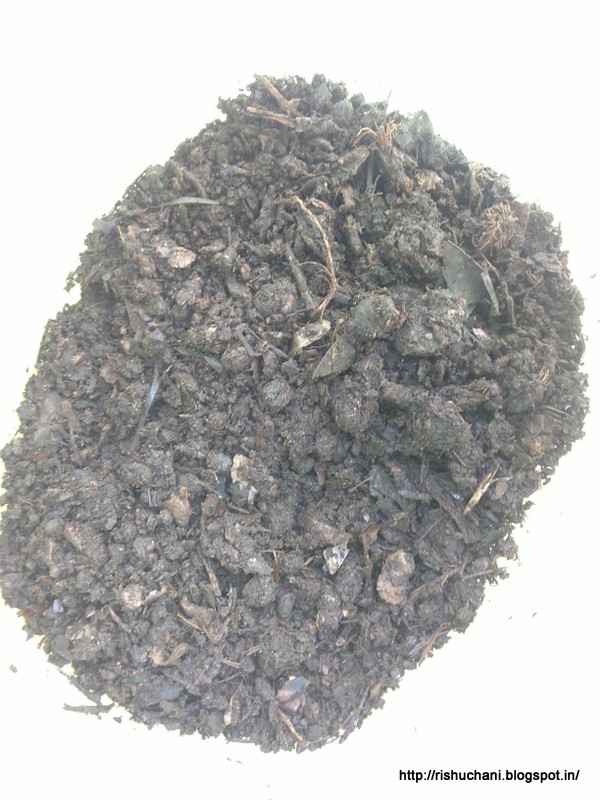
- Sieve the ready compost as below and use for your garden. There are some undone part once you sieve you can put leftover in next pile. This again help next pile to work faster.
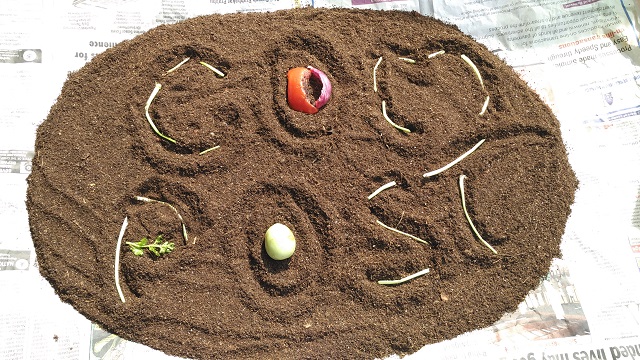
Once you take out ready compost from pot and if second pot is filled, use this first pot to continue the process. Happy composting!!
5 Tips and FAQ
- Add piece of lemon to avoid flies.
- Avoid cooked food if you are composting at home to avoid smell, it will also make process slow.
- Pile should be moist (not soggy or dry). If its dry add more vegetables and if its too wet add dry leaves or pieces of newspaper.
- Break material in small pieces to make process faster.
6 Copyright
Images used with permissions from the respective owners.
C – Waste Management Vendor Directory
Name | Phone | Web |
|---|---|---|
| Bengaluru East Eerullies | +91-9900131352 | |
| Bioflame | +91-9342012131 | |
| Blumarable | +91-7349474502 | http://www.blumarble.co.in/ |
| Daily Dump | +91-9945093095 | |
| E Save Promoters | +91-7204057502 | |
| Eco Clocks Conservation Projects | +91-9611619647 | |
| Eco-Gifts | +91-9686456668 | |
| EcoSave | +91-9844202861 | http://www.ecosave.in |
| Goinflora | +91-9972541469 | |
| GPS Renewables Pvt. Ltd. | +91-9741182413 | http://www.greenpowersystems.co.in/ |
| Green Utsav | +91-9591195277 | https://www.facebook.com/greenutsav/ |
| Hasirudala Innovations Pvt Ltd | +91-9742112362 | |
| Inflorescence garden services LLP | +91-9538109556 | |
| Maatti Enviro LLP | +919611896036 | http://www.indiamart.com/maatti-enviro |
| MK Associates | +91-9342553225 | |
| My Dream Garden | +91-7815022777 | |
| Oncrop Agro Sciences | +91-9845289412 | http://www.oncrop.com/ |
| One Hop Organics Pvt Ltd | +917259404888 | |
| Praanapoorna Natural Cleaners | +91-9900131352 | |
| Prudent Eco Systems | +91-9845341231 | http://prudentecosystems.com/ |
| Quantum Leaf | +91-9035274764 | http://www.facebook.com/quantumleafpage |
| Recover Habitat Pvt. Ltd. | +919480619059 | |
| Rent A Cutlery | +91-9591195277 | https://www.facebook.com/rentacutlery/ |
| Repair Cafe Bengaluru foundation | +91-9968686665 | |
| Saahas Waste Management Private Limited | +91-9108014621 | |
| Saahas Zero Waste | +91-9108014621 | |
| Shudh Labh Solutions Pvt Ltd | +91-7090798830 | |
| Soil and Health | +91-9481352125 | |
| Stonesoup | +91-9686523595 | |
| Trustbasket | +91-7411933573 | |
| Vermigold Ecotech Pvt Ltd | +91-8884444121 | |
| Visfortec Pvt Ltd | +91-9886715118 | |
D – Construction and Demolition Waste Management
(by Anu Govind)
(Disclaimer: This information is compiled by engaged citizens working to find solutions for C&D waste)
Managing ‘Construction and Demolition Waste’ or C&D Waste is a big challenge in Bengaluru. With huge amounts of construction, development, and demolition happening in the city, this waste stream is causing a humongous problem. Everyday, large parts of various lakes are disappearing and ugly mountains are appearing all over the place. Today we can see this C&D waste dumped on street corners, empty sites, footpaths and pretty much any convenient empty spot in the city. The shared pictures and the links to the newspaper articles that they were published in, illustrate the enormity of this problem in the Whitefield area. (Links: http://www.thehindu.com/news/cities/bangalore/a-noose-of-debris-tightens-around-varthur-lake/article18195923.ece, http://www.thehindu.com/news/cities/bangalore/illegal-dumpyard-threatens-kundalahalli-lake/article8322200.ece)
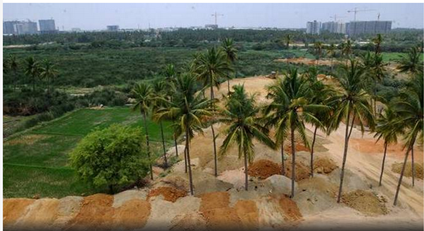
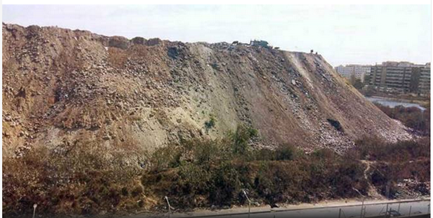
1 What Constitutes C&D Waste?
– Cement and Concrete
– Broken Bricks
– Broken Cement Plaster
– Steel (From RCC)
– Rubble
– Broken Stone
– Broken Timber
– Soil
– Rock/Gravel from Excavations
2 How is C&D Waste Generated?
– Demolition of existing structures
– Renovation of existing buildings
– Construction of new buildings
– Excavation/reconstruction of asphalt/concrete roads
– Construction of fly-over bridges/subways etc.
– Renovation/Installation of water/telephone/power/sewer lines etc.
– Collapse of a building due to an accident/natural calamity
3 How can a C&D Processing Facility help the City?
Hub and Spoke Model for C&D Processing FacilityThere will be an authorized destination for the C&D waste, so that our lakes and public spaces are spared. This setup is compliant with C&D Waste Management Rules of 2016 which were published by the Ministry of Environment, Forest and Climate Change last year.
https://kspcb.karnataka.gov.in/sites/default/files/inline-files/C%26D_rules_2016.pdf
3.1 Proposed Solution – Hub and Spoke Model
– Step I: Authorized Destination Site Identification (HUB)
- Identify 2-3 sites for handling C&D Waste in different parts of the city such that site distance is optimum from area where the C&D waste is generated
- Else transportation cost will be a huge challenge!
- Have a recycling /processing facility close to the site
- Authorized contractors (for large projects) come and drop the material at the processing facility
- From the ward collection point, BBMP to collect and send to the processing facility
- Provide all the facilities as mentioned in Schedule 1 of the C&D Waste Management Rules of 2016
- Keep track of the material inflow and outflow
– Step II: In each ward identify an area (SPOKE) that will be the drop-off point for a small quantity generator of C&D waste
- Periodically BBMP to pick up waste from these sites and drop it off at the closest site for processing/recycling
- Keep track of material inflow and outflow
– Step III: Publish all the information on the public domain
– Step IV: Penalize for non-compliance
3.1.1 Economic Advantages:
- Improvement of the income situation for the recycling industry
- More jobs for workers with low qualification levels
- Recovery of costs associated with transportation and tipping fees
- Good quality of waste materials stimulated by better prices
- Less waste ends up in landfills, increasing lifetime and reducing costs
- Return of waste materials into the materials cycle
- Lower prices than new materials
3.1.2 Environmental Advantages:
- Less primary resources, smaller raw materials’ warehouse
- Reduction of CO2 emissions
- Less production energy when recycling
- Smaller transport distances
- Recycling discourages illegal dumping
- Reduces negative environmental effects upon groundwater, surface-water, air, flora and fauna, and landscape
3.1.3 Social and Health Advantages:
- Reduction of proliferation of pests if C&D waste is deposited in controlled sites
- Avoids emissions into the air or leaching of toxic substances into the soil
- Unstable dumps and deposits are dangerous for civilians and workers
- Uncontrolled incineration of C&D waste can cause emissions of toxic compounds
- Lower growth rate of landfills and more space for productive uses
3.1.4 Recycling and Reuse of C&D Waste Material:
C&D waste can be used to make ‘manufactured sand’, pavers, bricks etc. The video below shows the solutions offered by a Bangalore based vendor called Rock Crystal.
The premises of Rock Crystal are located in Chickkajala (north Bangalore), and has the capacity to process 1000 tons per day (TPD) of waste. They work on a PPP model. The videos in the link below explains how C&D waste can be handled and converted to products.
(Though the unit has the capacity to handle 1000 TPD, C&D waste is not reaching this destination)
Another Solution from a Delhi Based Company:
4 References and Additional Material:
4.1 C&D WM Rules 2016
https://kspcb.karnataka.gov.in/sites/default/files/inline-files/C%26D_rules_2016.pdf
Here are some of the key points covered by this ruling:
I. Page 5 of the Rules
(9) Duties of State Government or Union Territory Administration-
(1) The Secretary in-charge of development in the State Government or Union territory administration shall prepare their policy document with respect to the management of construction and demolition of waste in accordance with the provisions of these rules within one year from date of final notification of these rules.
(1 year has elapsed after these rules came out in Mar 2016. However, no government policy available yet)
(2) The concerned department in the State Government dealing with land shall be responsible for providing suitable sites for setting up of the storage, processing and recycling facilities for construction and demolition waste.
(Sites have been suggested on paper, but nothing exists on the ground)
II. Page 4 of the Rules
(8) Duties of State Pollution Control Board or Pollution Control Committee-
(1) State Pollution Control Board or Pollution Control Committee shall monitor the implementation of these rules by the concerned local bodies and the competent authorities and the annual report shall be sent to the Central Pollution Control Board and the State Government or Union Territory or any other State level nodal agency identified by the State Government or Union Territory administration for generating State level comprehensive data.
(KSPCB has not ensured that this rule is implemented)
III. Schedule 1 gives the clear guidelines for:
Criteria for Site Selection for Storage and Processing or Recycling Facilities for Construction and Demolition Waste
[See Rule 7(1)]
– The processing site to be fenced
– Approach road shall be concreted or paved
– Provision of weigh bridge to measure quantity of waste bought in
(None of these provisions exist in any of the proposed sites)
4.2 BBMP Notification (March 2016)- Guidelines for C&D Waste Management:
I. BBMP came out with an official notification on March 18th 2016 on the ‘Guidelines on Construction and Demolition Waste Management’:
II. May 2016
A new circular on May 7th 2016 was a notification of waste disposal sites:
https://bbmp.gov.in/documents/Scan.pdf%2017-05-2016.pdf
(No BBMP authorized site is functional yet. No Official on the ground is aware of any authorized C&D sites. Tenders have been called for without defining the destination site)
4.3 Karnataka State Pollution Control Board is responsible for ensuring the implementation of the C&D waste management rule 2016
https://kspcb.karnataka.gov.in/environmental-acts-rules
(No action has been taken by kspcb to implement this rule)
4.4 High Court Direction (November 2015)
HC has directed BBMP to identify sites and seek proposals for C&D Management
(http://bangaloremirror.indiatimes.com/bangalore/civic//articleshow/49807439.cms?)
4.5 How C&D Waste Dumping is killing so many lakes in Bangalore
E – Resource Recovery Center Project
1 Problem Definition:
Bangalore generates 3000-4000 tons of waste per day. 60% of this waste is organic and should ideally be composted in a decentralized fashion, close to source. However, there isn’t enough composting happening due to a lack of awareness and understanding. Additionally, the dry waste that is generated can be classified as high value waste, which typically ends up with a recycler in the informal sector and low value waste, which gets burnt or dumped into lakes and storm water drains or sent to a landfill, all of which have an ecological impact. When segregated garbage is not handled responsibly, residents do not feel inclined to segregate their garbage as mandated by BBMP.
Waste pickers in the city collect discarded materials that have zero value and convert it into a tradable commodity through their labor in extraction, collection, sorting, grading and transporting (Alliance of Indian Waste pickers). They work in the informal economy and do not have the training or equipment to handle waste correctly. They are mostly immigrant women who belong to one of the most marginalized sections of the urban landscape with no education, poor compensation, no health benefits, toxic working conditions, no government benefits and no education for their children.
2 Proposed Solution:
The plan is to tackle the garbage issue one ward at a time, throughout Whitefield.
3 Project Goals:
- Collect and Process all the dry waste that BBMP & Hasiru Dala collects from Ward 84 (Hagadur Ward). Expected to be 800-1200 kgs/day. Ideally needs to be 1.5 tons per day. Collection of garbage at these levels has been successfully done at other 29 units where Hasiru Dala operates the DWCC.
- Waste aggregation center for non-recyclable, low value dry waste for the ward & neighboring wards. These include unusable cloth, foot ware, multi-layered and fused packaging material (chips, biscuit packets, small medicine bottles etc.). The goal is to bale this waste which is then used as feeder material to making Refuse Derived Fuel (RDF). RDF needs to make up at least 5% of Cement kiln or any industry using solid fuel per the 2016 Solid Waste Management Rules. This unit may be the first in the country to model collection, aggregation and preparation of feeder material for RDF. Currently, these low value non-recyclables are either burnt, dumped into lakes or sent to a landfill. The plan is to process 650 kgs to 1 ton of such material per day.
- Showcase various composting methods for wet waste and leaf litter. This facility can help educate housekeeping staff, school children and others who may not know the value of compost or how to make it. Additionally, this unit can process the wet waste for the immediate neighborhood who may not have a composting facility and garden waste for the entire ward. Expected volume to be processed is 1.5 tons per day including 250 kgs of garden waste per week (which typically gets burnt especially during the dry season). ____________________________
4 Livelihood and social goals:
- After extensive surveys, 65 families of waste-pickers and informal waste collectors in Ward 84 will be enrolled as members (later to be extended to Dodnekundhi, Ward No: 85 with 280 households)
- Support for schooling of children of waste pickers by enrolling them into government / bridge schools and providing low cost loans.
- Running campaigns against burning of garbage and child marriages.
5 Operational Model
After the Dry Waste center is built, the aim is to have it operated by an entrepreneur who will take ownership and run the unit in a profitable fashion. Hasiru Dala will identify this entrepreneur from the neighborhood, provide training (Jain university certificate course) and managerial support to this entrepreneur. Hasiru Dala will also be responsible to provide oversight of the operations and ensure that fair wages are paid to the employees, child labor is not used, garbage is handled or managed in an appropriate fashion etc.
29 Dry Waste Collection centers run by Hasiru Dala in the city are run via an individual entrepreneur model.
The MoU will be between BBMP and this entrepreneur for a period of 3 years. Hasiru Dala will manage and run the RDF aggregation unit and the Compost Academy.
Whitefield Rising will aid these MoUs and provide a supporting role to ensure that they are properly executed.
United Way of Bengaluru will be responsible for managing and providing reporting on all aspects of the project and money and any statutory reporting. They will also appoint a project manager to run this project and assist with obtaining government approvals.
6 Why is this a great idea?
Whitefield Rising is partnering with Hasiru Dala and United Way Bengaluru for this project. Founded in 2013, Hasiru Dala is a membership based non-profit organization of waste-pickers which strives to integrate marginalized waste-pickers in the solid waste management framework by utilizing their expertise in the domain. Their membership of 7400 waste pickers manages 29 Dry waste segregation centers in Bangalore and diverts nearly 90% of dry waste away from landfills.
A little over an acre of land has been allotted by BBMP for this project for this facility here and the Corporator of Hagadur Ward is aware and supports this project. Garbage burning and dumping of waste into neighborhood lakes, especially into Varthur Lake has contributed to polluting the land and water of Whitefield.
Additionally, given Hasiru Dala’s focus on cultivating and nurturing entrepreneurs in the solid waste management business and in main-streaming this marginalized profession, this unit would improve the livelihood of 20 workers and their families when the unit is fully operational. Additionally, their children could be encouraged to enroll in the neighborhood (Vijayanagara) Government School, which is being renovated as a part of another Whitefield Rising project.
7 Key Stakeholders:
- BBMP Commissioner: Manjunath Prasad
- BBMP Health/SWM Joint Commissioner: Sarfaraz Khan
- BBMP Zonal Commissioner, Mahadevpura : Dr.Vasanthi
- Project Sponsors: CSR India & Ikanos India (Qualcomm India subsidiaries) Karnataka Home Minister: K.J.George
- MLA, Mahadevpura Constituency: Aravind Limbavali
- Corporator, Hagadur Ward: Uday Kumar
- Community Partner: Whitefield Rising – Anu Govind, Murali Govindarajulu, Viji Vennelakanti, Nitya Ramakrishnan
- Knowledge & Implementation Partner: Hasiru Dala – Nalini Shekar, Marwan Abubaker
- Project Partner: United Way Bengaluru – Manish Michael, Rajesh Krishnan
8 Estimated Time for Completion:
15 months from start date, after receiving funding and all government approvals. Project expected to start in April 2017.
9 Approvals Needed:
- Local Corporator has already approved the project.
- BBMP has already issued a letter to initiate this project.
- An MoU needs to be signed between BBMP and an entrepreneur to commence operations.
10 Challenges foreseen:
- Issues with neighbors who may prevent the completion of this project due to perceptions regarding how waste will be processed. This resistance could be addressed by regularly publishing information on the project and education neighbors on the benefits and how the unit will be maintained post go live.
- Land related delays are often seen as the biggest delay and this unit is lucky to have the land already allocated by BBMP. After much follow up by Whitefield Rising, the Thalisdar has outlined the land allocated to the project. There is a piece of encroached land which would need to ideally be cleared. However, it has not been considered in the construction plan.
- There is an existing Dry Waste Collection Center and garbage unloading unit which will need to be relocate across the street to make way for this construction.
11 Current Status
May 2 2017 – BBMP Fencing work has been stopped due to alleged ownership issues with the land. The Corporator Mr Uday Kumar has committed to resolving it. Without this, the project cannot even begin. The design of the structure is based on the allocated land (which is received in writing);
